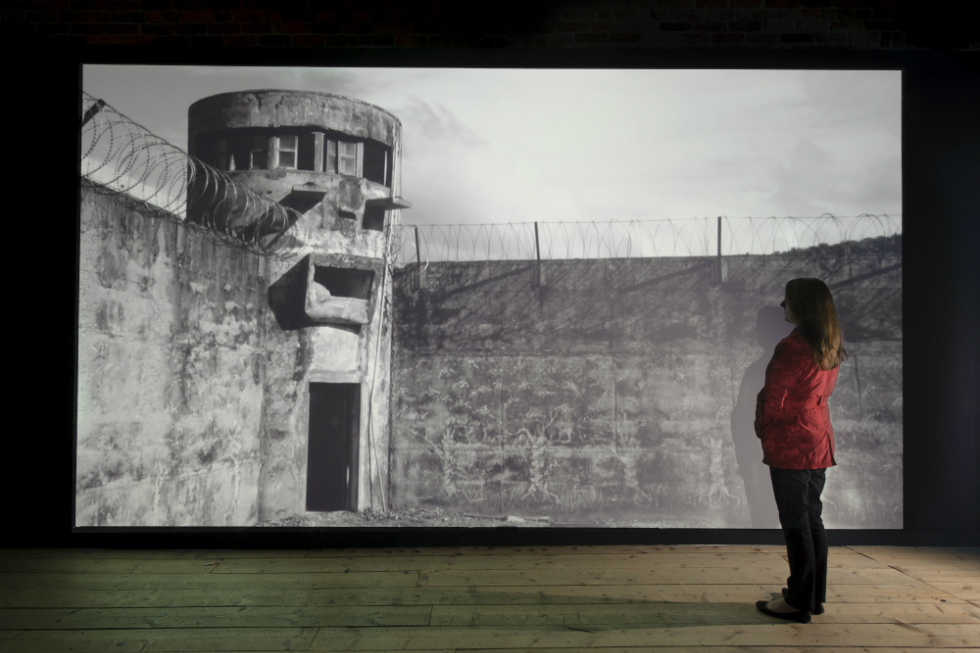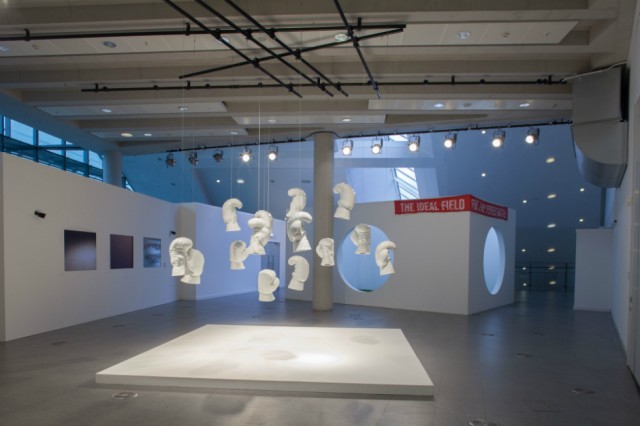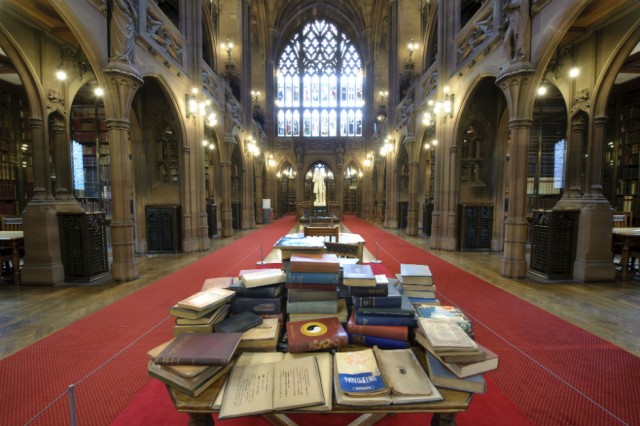Lost In Translation? Harmonious Society — Reviewed

Linda Pittwood visits Asia Triennial’s major new exhibition of Chinese contemporary art, Harmonious Society, and finds a broad and diverse offering of artworks all attempting to translate the culture of China. But does it work?
Before we begin looking at Harmonious Society in detail, first a few thoughts on perennial exhibitions. Why do they occur? What do they mean in relation to other kinds of exhibition production? Obviously these are huge questions, and to answer them fully would take more time than we have here, but we will consider a few ideas.
When dOCUMENTA inaugurated in 1955 in Kassel, Germany, it had a healing mission: responding to the way that culture had become politicized in the Second World War. Venice Biennale on the other hand, founded in 1895, similarly to the Great Exhibition of 1851 in London, was more concerned with national pride: announcing to the world what a nation is capable of using examples from fine art or industry.
Latterly, perennial exhibitions lead the way in setting trends and presenting artists that will then inspire other exhibitions. Curator, artist and writer Paul O’Neill describes them as: “interfaces between art and larger publics – publics which are at once local and global, resident and nomadic, non-specialist and art-worldly”, and explains that contemporary curatorial practice occurs: “on an increasingly inter-national, trans-national and multinational scale, where the ‘local’ and the ‘global’ are in constant dialogue.”
With this in mind, we now travel to Manchester City Centre for Asia Triennial 2014, and specifically to the six-venue sub-strand, Harmonious Society. It is a 30 artist-strong exhibition of Chinese contemporary art, led by the Centre for Chinese Contemporary Art (CFCCA). Chinese content dwarfs the rest of the Triennial programme: even some of the events that sit outside of this sub-festival involve it. The emphasis given to China is likely because we are 14 years into the ‘Chinese century,’ but also very possibly because this country’s contemporary art has matured in the UK as an area of academic focus and curatorial concern.
When I spoke to Dr Jiang Jiehong, curator of Harmonious Society and Professor of Chinese Art at Birmingham City University, back in February, he touched on the curatorial processes that were underway to create the show. He impressed me with the rigour and the sensitivity with which he had approached the task of lead curator on the project, as well as his acknowledgement that what he was undertaking was an exercise in cultural translation.
In the four cultural centres – Beijing, Shanghai, Hong Kong and Taipei – he initiated four different approaches to facilitate new artworks and curatorial endeavors, including workshops and symposia. But how have these curatorial structures translated into an exhibition experience?

It is not obligatory but it makes sense to begin Harmonious Society at the CFCCA venue on Thomas Street. The two artists selected for the show here make the point that the ‘harmonious society’ (or ‘societies’) to which the title refers are both Chinese and non-Chinese: that the artists of modern China are self-reflective as well as outward looking. Liu Xiaodong’s output is the result of four weeks in Israel. His diary entries are in some ways more poignant than his canvasses, documenting intimate encounters and observations. In contrast, Pak Sheung Chuen’s project, Resenting Hong Kong Series: Resenting My Own History, takes a lighter vox-poppy approach to the subject of transfer of Hong Kong sovereignty from Britain back to China in 1997.
To navigate the six venues, visitors are equipped with a map, beautifully designed by Hong Kong-born, Manchester-raised artist and illustrator Stanley Chow. Leaving Thomas Street, my next destination was the National Football Museum, where the works have been chosen or commissioned to relate to ideas of sport, games and power. A piece by Shanghai-based artist Liu Jianhua, Boxing Time (2002), is my highlight. Liu has produced a huge variety of work in ceramic, often exploring the tension between the hardness and fragility of the material. It’s a real bonus to have films here of the artists talking about their work.
The other artwork of interest here is Kan Xuan’s Man with Balls (2005). In it she explores the relationship between golf and business: how sport can so often be masculine and exclusionary. This is resonant within a venue that attracts a principally male audience. Whether many of the traditional visitors have taken the lift to the third floor to see Harmonious Society is unclear (conversely visitors coming specifically to see the exhibition need not encounter a great deal of football as they trace their way to the show), the invigilator admits that the younger visitors love it; which is to be expected, as I find the exhibition here is the most fun of all the six venues.
In an extreme but not unpleasant change of tone, my next destination is Manchester Cathedral. Both the works here are new commissions. Zheng Guogu’s Brain Lines consists of 13 retro-looking units with a periodic table aesthetic, one to represent each of the twelve apostles and Jesus. Li Wei’s sculpture, however, responds to the cathedral architecture; he has chosen to create an ornate and ‘mystical’-looking frame around a full height mirror. Whilst both are sensitive to their surroundings and have a contemplative quality, they tread too softly for my liking and in the case of Li especially, feel a bit tucked away.
The works that best exemplify curator Dr Jiang’s mission to translate the culture of China for UK audiences can be found at the John Rylands Library. Wang Yuyang’s Breathing Books is, in my view, the most effective but subtle work from the entire selection of 30 artists. Having visited the library and taken photographs and measurements of the Chinese books, Wang returned to China to produce a silicon sculptural facsimile of them all piled on a table. Presented in the reading room, responding to a motion sensor, the books inflate so as to appear to breathe as one. This gesture embodies the importance of recording and exchanging knowledge, and is rooted specifically in the relationship between China and the UK. Most importantly, it is a wonderful, surprising work.
The next venue on the map, Artwork, is a few minutes walk into Salford, and is scruffy and a touch unwelcoming. However, it is the only space big enough to accommodate large immersive works. Pairing Zhang Peili’s Elegant Semicircles with Wang Yin’s joyous dance paintings on the top floor is particularly effective in such an industrial context. The works here are a catalogue of familiar artistic strategies (some ready-mades, a hint of Joseph Beuys) but together they form a distinctively Chinese lens with which the artists have interpreted their experiences.

Curator Dr Jiang made reference to one problem that it is worth bearing in mind when visiting Harmonious Society, that: “an artist who has put 100% effort into their work when it is shown in one cultural context may find that only 20% will be understood in a new cultural context. This is a two-way process which also affects British art shown in China.” A decision has clearly been taken not to overload the displays with interpretation; however, as I walk around Harmonious Society, there are some questions without answers, some intrigue without resolution, some meanings and messages that elude me.
The venue where I felt most alone was the Museum of Science and Industry (MOSI), my last destination of the day. Tonally this section of the exhibition, mostly video work, felt the most mournful and perhaps pessimistic. Some of the works begged for more explanation. Chen Chieh-jen’s four-screen exploration of a Taiwanese leprosy hospital, Realm of Reverberations (2014), in particular deserves substantial attention, befitting the artist’s thoughtful and intensive research process. Those visitors with the luxury of revisiting the exhibition might find it worth approaching this venue as a trip on its own.
On reflection, and similarly to its first big ‘expo’ exhibitions (some of which became perennial fixtures in our artistic calendars), this strand of the Asia Triennial Manchester first and foremost is concerned with showcasing some of China’s exciting artists. However, we are invited to reflect on China itself, not just Chinese contemporary art. Dr Jiang suggests that the exhibition is “a platform for audience, artists and curators to discuss this era of extraordinary social, ideological and cultural transformation.”
The title Harmonious Society appears politically loaded, suggesting a tension between the internal and external perception of a situation, and even hints at the use of propaganda. Assessing the exhibition alone, and not the extensive public programme, I find that the artists who are outsiders offer the most insight, whereas some of the pieces that directly deal with politics inside China — such as Yang Zhenzhong’s Long Live the Great Union and Wang Yin’s dancing paintings — are less forceful. However, I would exclude Chen Chieh-jen’s Realm of Reverberations video from that statement.
In a sense, all the artworks are outsiders in their current context in Manchester, although they are all part of the international art world; as mentioned at the start of this article, they are what curator Paul O’Neill calls ‘interfaces’ between one culture and another. We have a fantastic and time-limited opportunity to view them here, where some of the meaning may be lost but new meanings are made.
Linda Pittwood, Arts Editor
Harmonious Society, as part of Asia Triennial Manchester 14, continues until 23 November 2014 at venues across Manchester — free entry
See full programme and participating venues at asiatriennialmanchester.com
Read our Big Interview with Asia Triennial Director Alnoor Mitha
Images top to bottom: Chen Chieh-jen, Realm of Reverberations (2014), photo courtesy Joel Chester Fildes. Liu Jianhua Boxing Times (2002), photo courtesy Tristan Poyser. Wang Yuyang, Breathing Books (2014), photo courtesy Joel Chester Fildes





